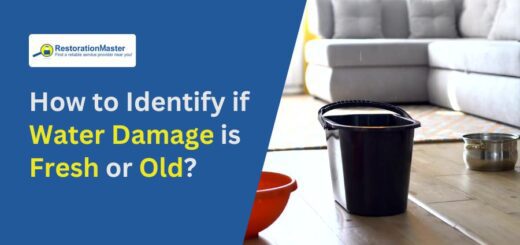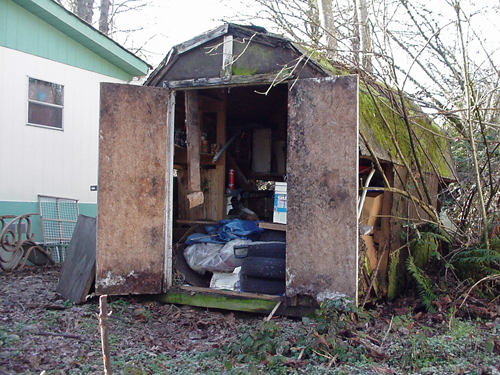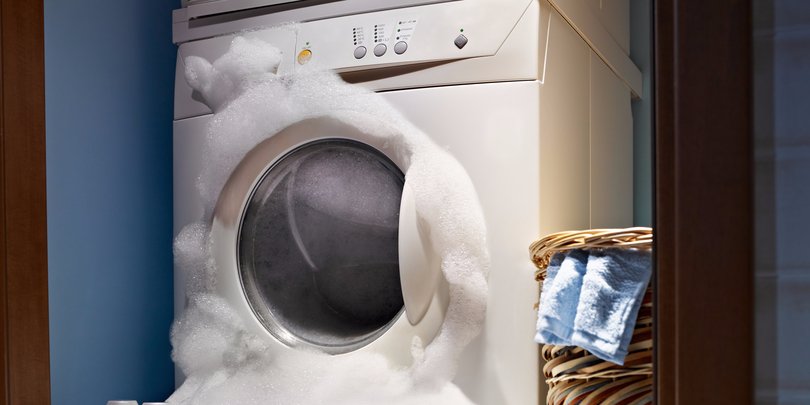Dry Rot vs Wet Rot: How to Fix Both
Summary: Wet rot comes from water damage, making wood damp and decaying it. Dry rot occurs in humid, poorly ventilated places, causing wood to decay without direct water contact. Fixing water damage promptly is key to preventing both types of rot from damaging structures.
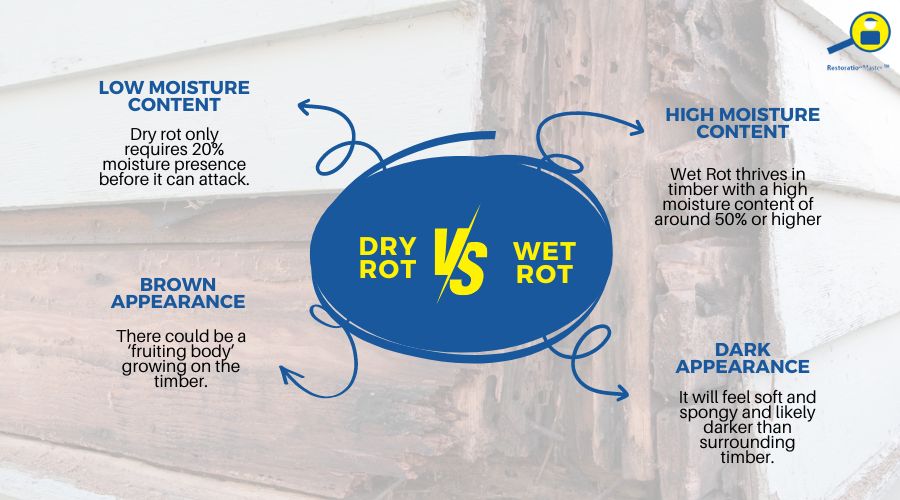
Wood rot is a threat to any home since the majority of houses are built with wood. Both dry rot and wood rot can occur. To preserve the integrity of the home’s structureStructure refers to the framework or components of a buildin... More, homeowners must recognize the differences between the two and take steps to repairRepair is the act of fixing or restoring damaged property, m... More the issue or call water damage restoration experts to address the problem.
Why are Homes Primarily Built of Wood?
In the United States, wood remains the preferred construction material for houses. Despite the greater resistance of brick and concrete, wood is favored due to its flexibility and ability to withstand tornadoes. It is readily available and facilitates easy home construction.
The typical American home extensively utilizes timber. Wood forms the frame of the house, as well as components such as doors and even the foundation. Outside, numerous wood planks are used for features like the porch and balcony.
What are Threats to Wood Materials?
One of the primary concerns regarding wood materials is rot, which is a type of decay caused by moisture and fungiFungi are a group of organisms, including mold, mildew, and ... More. FungiFungi are a group of organisms, including mold, mildew, and ... More are attracted to damp wood, particularly wood that remains moist for extended periods, as these microscopic organisms do not inhabit dry wood.
As fungiFungi are a group of organisms, including mold, mildew, and ... More feed on damp wood, the wood gradually weakens and breaks down. The cavities formed in rotted wood allow moisture to penetrate, leading to further damage to the material. Severe wood rot compromises the integrity of the home’s structureStructure refers to the framework or components of a buildin... More. Wood rot can be categorized as either dry or wet.
What is Dry Rot?
Fungus causes the breakdown of wood, leading to dry rot. In dry rot, the cellulose and hemicellulose are affected; these two components give wood its strength and stability and influence its longevity. Weak and brittle wood are the outcomes when fungiFungi are a group of organisms, including mold, mildew, and ... More attack and compromise the cellular structureStructure refers to the framework or components of a buildin... More.
Despite its name, dry rot occurs when moisture is present. The fungiFungi are a group of organisms, including mold, mildew, and ... More thrive in damp conditions. When the moisture contentMoisture content is the amount of water present in a materia... More of the wood exceeds 20 percent, fungus grows. Similarly, the fungiFungi are a group of organisms, including mold, mildew, and ... More settle in wood that is exposed to extreme humidityHumidity is the amount of moisture or water vapor present in... More or sits in water.
What is Wet Rot?
Wet rot is another threat caused by a species of timber-eating fungiFungi are a group of organisms, including mold, mildew, and ... More, such as Coniophora Puteana, commonly known as cellar fungus. The nutrients and moisture in the wood nourish the fungal sporesSpores are microscopic reproductive units of fungi or mold t... More. Wet rot spreads by releasing sporesSpores are microscopic reproductive units of fungi or mold t... More into the atmosphere in moisture-rich areas.
Wet rot falls into either of two categories: white rot or brown rot. Untreated wet rot of either type can leadLead is a heavy metal that can be toxic to humans, especiall... More to seriously compromised structural materials. When the wood loses its strength upon being attacked by fungus, the structureStructure refers to the framework or components of a buildin... More can be unsafe and even dangerous to occupy.
Where Does Dry Rot Occur?
Homes in any climate or region are susceptible to dry rot. Common parts of a house that can be affected by dry rot include the attic, steps, and windowsills; the basement and areas beneath the sink are also vulnerable. Outside, dry rot can impact the deck, eaves, and fencing.
Where Does Wet Rot Occur?
Wet rot is most commonly found in the cellar of properties. Likewise, a home’s roof can be severely affected by wet rot. The wood around windowsills, especially when continuously exposed to moisture and condensation, is a prime target for wet rot.
How is Dry Rot Identified?
Dry rot can be identified by a few key signs. You might notice a musty, damp smell in the affected area, which is a pretty obvious clue. Visually, look for cracked or shrunken wood that feels brittle or crumbles easily. Sometimes, you’ll see fuzzy, white or grayish growth on the surface of the wood, which is a sign of fungal activity. As dry rot gets worse, the wood might darken and develop these square-shaped cracks. If you tap on the wood and it sounds hollow, that’s another red flag.
How is Wet Rot Identified?
The signs of wet rot, similar to those of dry rot, can be challenging to distinguish. However, several indicators can help identify it. One key sign is the darkening of wood, notably distinct from the surrounding areas. Moreover, affected wood tends to feel soft and spongy upon touch, with a propensity to crack and crumble under pressure. These telltale traits provide essential clues for detecting and addressing the presence of wet rot in wooden structures.
What Causes Dry Rot?
Dry rot can occur after moisture has infiltrated the wood. Situations where water damage is a likely outcome include in the aftermath of floodingFlooding is the overflow or accumulation of water in areas t... More and natural disasters. Similarly, poor ventilationVentilation is the process of exchanging or circulating air ... More, plumbing leaks, and condensation, are common contributors to the development of dry rot. For example: A burst pipe spews water, creating moist conditions in which fungiFungi are a group of organisms, including mold, mildew, and ... More flourish. Additionally, using improperly dried wood for construction can precede the occurrence of dry rot.
What Causes Wet Rot?
Exposure to moisture leads to wet rot, which typically develops in areas where plumbing leaks and condensation occur. Additional causes include roof defects and blocked or leaky gutters. Wet rot can also manifest in bathrooms around bathtubs, especially when dampness penetrates the walls.
Both dry and wet rot pose significant issues for homeowners. To prevent wood rot, it’s essential to keep excess moisture out of the home. This can be achieved by annually inspecting the roof for leaks, ensuring gutters direct water away from the home, and upgrading the ventilationVentilation is the process of exchanging or circulating air ... More systems in bathrooms, kitchens, and attics.
How to Repair Wood Rot?
There are distinct methods for repairing dry rot and wet rot, yet several common steps apply to both:
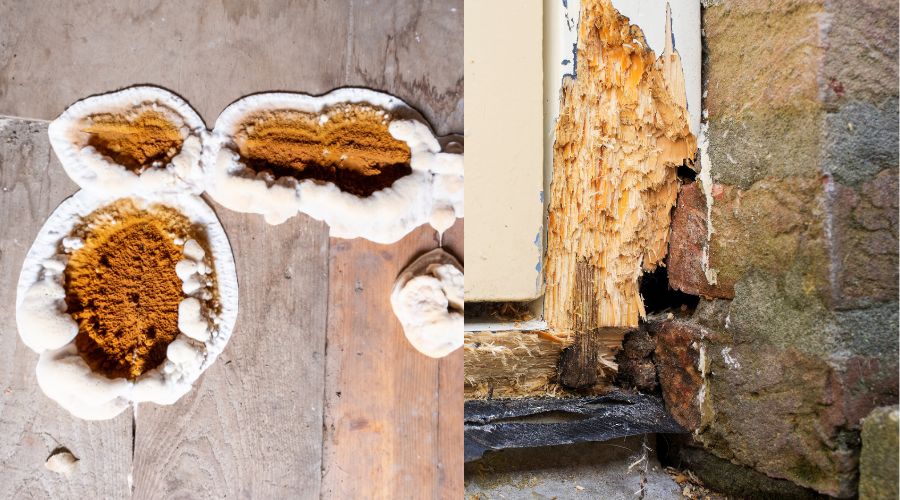
How to Repair Dry Rot?
- Stabilize the wood: Begin by treating the dry rotted wood with a wood hardener. This helps strengthen the weakened areas and prevents further deterioration.
- Fill in Gaps: After stabilizing, use epoxy wood filler to fill any gaps or holes left by the dry rot. This fills the damaged areas and restores the wood’s structural integrity.
- Smooth and Reinforce: Once the filler has dried, sand the surface smooth and apply a consolidant to reinforce the repaired area.
How to Repair Wet Rot?
- Remove Rotten Wood: Cut out any soft or rotten wood affected by wet rot. Check nearby wood for structural damage too.
Common Steps For Both
- Kill SporesSpores are microscopic reproductive units of fungi or mold t... More: Treat the area with a fungicide to kill any remaining sporesSpores are microscopic reproductive units of fungi or mold t... More and prevent further spread of rot.
- Replace if Necessary: In severe cases, replace damaged wood entirely with rot-resistant material.
- Keep an Eye: Regularly check the area for signs of recurring rot and address any issues promptly.
Call Professionals for Water Damage Repair & Reconstruction Services

If you spot wood rot, it’s important to address the moisture problem and reach out to water damage repairRepair is the act of fixing or restoring damaged property, m... More professionals promptly. Experienced technicians will quickly assess the damage, locate and repairRepair is the act of fixing or restoring damaged property, m... More the water source, and use advanced equipment to remove excess moisture. They’ll ensure thorough dryingDrying is the process of removing moisture from materials, s... More of the property and clean and deodorize rugs and carpets. Any mold infestations will be eliminated, and if needed, they’ll repairRepair is the act of fixing or restoring damaged property, m... More and reconstruct damaged areas. They’ll also assist in expediting insurance claims.
For reliable water damage repairRepair is the act of fixing or restoring damaged property, m... More and reconstruction services, RestorationMaster is the go-to choice.










